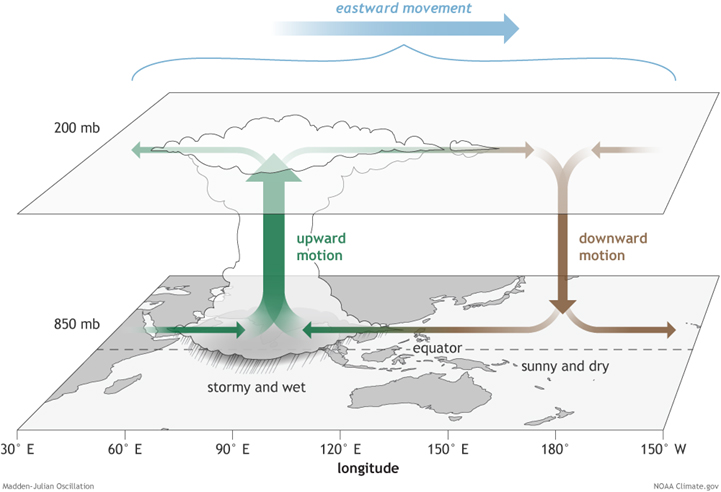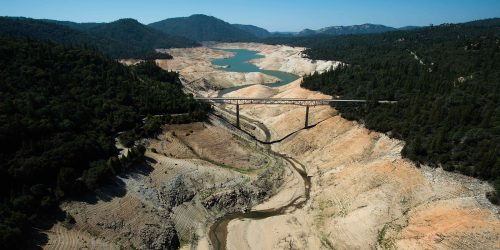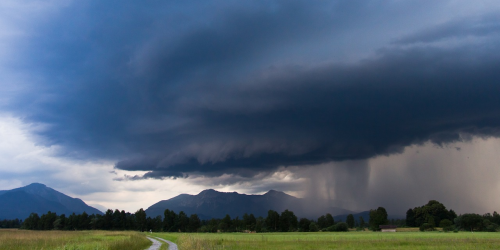NOAA’s Climate Variability and Predictability (CVP) program is announcing 14 new three-year projects in FY17 that aim to improve understanding of processes that affect the propagation of intraseasonal oscillations—specifically the Madden-Julian Oscillation (MJO)—in the Maritime Continent and broader regions. The competitively selected programs total $7.4 million, including $4.8 in grants and $2.6 in other awards.

CVP supports research that enhances our process-level understanding of the climate system through observation, modeling, analysis, and field studies. Since 2011, CVP has sponsored research projects focused on improving scientific understanding of the MJO, a 30- to 90-day natural climate variability pattern that starts in the Indian Ocean and propagates around the world. Improvements in our understanding of the MJO—how it is initiated and how it travels around the globe—will increase our prediction skill within the 2-week to 3-month time window where there is currently a skill gap.
Better understanding of the MJO would also increase the accuracy and lead time for predicting extreme weather over the United States, thus improving people’s ability to prepare for dangerous conditions, such as very heavy precipitation caused by “atmospheric rivers.” On average, about 30-50% of the west coast’s annual precipitation occurs in just a few atmospheric river events, which sustain the region’s water supply but can also produce damaging flood disasters.
In collaboration with the Office of Naval Research, CVP is expected to support activities of the Propagation of Intra-seasonal Tropical Oscillations (PISTON) Departmental Research Initiative with the projects funded in FY17. The CVP component of the PISTON also contributes to the Years of Maritime Continent (YMC), an international project that creates a collaborative framework for multi-disciplinary field observations and modeling to better understand the role of the Maritime Continent on the global weather-climate continuum. YMC is co-led by the Indonesian Meteorology Service (BMKG) and the Japan Agency for Marine-Earth Science and Technology (JAMSTEC).
The selected projects investigate different processes that affect the speed, intensity, disruption, and/or geographic placement of the MJO propagation by using a combination of in-situ/ ship-based/remote observations, data analysis, modeling, and/or theoretical understanding of local and remote processes.
The new competitively selected projects funded by the CVP program in FY17 are:
- Role of Air-Sea-Land Interaction in the MJO Prediction Barrier over the Maritime Continent: A Cloud-Resolving Coupled Modeling Study
- Lead PI: Shuyi Chen (University of Washington)
- Co-PI: Chris Fairall (NOAA/ESRL)
- Ship-based Observations of Atmospheric Boundary and Ocean Interactions near the Philippines during PISTON
- Lead PI: Chris Fairall (NOAA/ESRL/PSD)
- Co-PI: Alan Brewer (NOAA/ESRL/CSD)
- Modulation of MJO-Diurnal Cycle Interaction over the Maritime Continent
- Lead PI: Samson Hagos (PNNL, Battelle Memorial Institute)
- Co-PI: Robert Joyce (NOAA/NCEP); Chidong Zhang (NOAA/PMEL);
- Collaborator: Agie Wandala Putra (BMKG)
- Influences of the Maritime Continent on the Eastward Propagation of the Madden-Julian Oscillation
- Lead PI: Xianan Jiang (UCLA)
- Co-PI: Ming Zhao (GFDL/NOAA), Duane Waliser (UCLA/JPL), Baoqiang Xiang (GFDL/NOAA)
- Collaborator: Shian-Jiann Lin (GFDL/NOAA)
- Spatial structure of diurnal variability from profiling float arrays
- Lead PI: T. M. Shaun Johnston (Scripps)
- Co-PI: Daniel L Rudnick (Scripps)
- Propagation and predictability of the tropical intraseasonal oscillation in the Maritime Continent region
- PI: Kazuyoshi Kikuchi (University of Hawaii)
- Co-PI: George N. Kiladis (NOAA/ESRL/PSD), Kunio Yoneyama and Tomoe Nasuno (JAMSTEC), Tomoki Miyakawa (U. Tokyo)
- Maritime Continent as a barrier to the MJO propagation: an analysis of the sensitivity of convection to column moisture
- Lead PI: Zhiming Kuang (Harvard University)
- Collaborator: David Adams (Universidad Autonoma de Mexico)
- Producing and diagnosing a regional analysis with data assimilation at a cloud-permitting scale to support YMC and PISTON
- Lead PI: Zhaoxia Pu (University of Utah)
- Co-PI: Agie Wandala Putra (BMKG)
- Collaborator: Chidong Zhang (NOAA/PMEL)
- Controls on upper ocean processes that impact intraseasonal variability in the Maritime Continent Region
- Lead PI: Kelvin Richards (University of Hawaii)
- Identifying the Relative Roles of Precursors Associated with Observed versus Modeled MJO Propagation across the Maritime Continent
- Lead PI: Naoko Sakaeda (NOAA/ESRL/PSD)
- Co-PI: Juliana Dias (Uni Colorado/CIRES) and George Kiladis (NOAA/ESRL/PSD)
- Convective multi-scale interactions over the Maritime Continent during the propagation of the MJO
- Lead PI: Courtney Schumacher (Texas A&M University)
- BMKG radar team: Mr. Riris Adriyanto (Head of Division for Remote Sensing Imagery Management), Mr. Taufiq Hidayah (Chief of Radar Data Management Sub Division), Mr. Iddam Haeruly Umam (radar meteorologist), Mr. Wahyu Argo (radar meteorologist), Mr. Abdullah Ali (radar meteorologist)
- Upper ocean processes in the Maritime Continent and their impact on the air-sea interaction and MJO predictability
- Lead PI: Toshiaki Shinoda (Texas A&M University – Corpus Christi)
- Co-PI: Hyodae Seo (WHOI), Wanqiu Wang (NOAA/NCEP/CPC)
- The Role of Ocean Stratification in the Propagation of Intraseasonal Oscillations
- Lead PI: Janet Sprintall (Scripps)
- High-Resolution Precipitation Product and Analysis for YMC
- Lead PI: Chidong Zhang (NOAA/PMEL)
- Co-PI: Pingping Xie (NOAA/NCEP/CPC), Robert Joyce (NOAA/NCEP/CPC), and Brandon Kerns (U Miami); Iddam Hairuly Umam (BMKG); Reza Bayu Perdana (BMKG)





